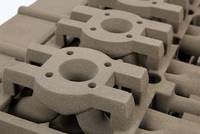In a recent announcement voxeljet has debuted a newly developed Phenolic-Direct-Binding method. This new binding method not only offers key advantages for sand printing but also allows for the production of ceramic molds.
The new binder offers a number of advantages for many 3D printing applications, as process engineer Dr. Florian Mögele can attest: “With this binder, we are able to achieve an incredible level of resolution and precision in 3D printing. At the same time, we have also made significant improvements in terms of stability and sand recycling. And: phenolic resin binders are ideally suited for processing ceramic and other materials.”
3D printed, complicated PDB sand molds surpass even the highest expectations. The Phenolic-Direct-Binding method, with its impressive accuracy and increased strength, is setting new trends, especially for complex molds with undercuts, elaborate details and very small radii.
The phenolic resin that is used is not toxic and allows for 100% recycling of non-printed particle material. In contrast to conventional binders, the PDB process does not require silica sand to be pre-treated, which means that it can be easily returned to the sand cycle.
Read more at ENGINEERING.com


